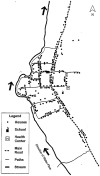An observational study on the effectiveness of point-of-use chlorination
- PMID: 19408433
- PMCID: PMC2881824
An observational study on the effectiveness of point-of-use chlorination
Abstract
Although the efficacy of chlorine disinfection under controlled laboratory conditions is well known, the effectiveness of chlorine under field point-of-use (POU) conditions is still not clearly understood and may be impacted by a variety of factors. This study evaluated the effectiveness of POU chlorine disinfection in rural Ecuador under typical use conditions and compared this effectiveness with the efficacy in controlled laboratory conditions. While reductions of indicator organisms were slightly higher in households that used chlorination, no significant differences were seen between households employing POU chlorination and the households with no chlorination (1-1.5 log10 median reductions for chlorinating households and 0.31-0.55 log10 for nonchlorinating households, depending on the indicator organism). In contrast, significant reduction of all test organisms was found when simulating POU conditions in the laboratory. This study demonstrates that POU chlorination can be considerably less effective under actual field conditions than would be predicted based on its laboratory efficacy (3-5 log10 median reductions for chlorinated and 0-0.3 log10 for nonchlorinated samples). Human factors (including improper storage and chlorine dosing) and uncontrolled water quality effects are hypothesized to impact significantly the effectiveness of chlorine disinfection.
Figures
Comment in
-
Comment on "An observational study on the effectiveness of point-of-use chlorination".J Environ Health. 2009 Sep;72(2):38-9. J Environ Health. 2009. PMID: 19761007 No abstract available.
-
Comment on "An observational study on the effectiveness of point-of-use chlorination".J Environ Health. 2010 Jan-Feb;72(6):74, 78; author reply 78. J Environ Health. 2010. PMID: 20104840 No abstract available.
References
-
- Adams MR. Bacteriophages. New York: Wiley Interscience; 1959.
-
- Arnold BF, Colford JM., Jr Treating water with chlorine at point-of-use to improve water quality and reduce child diarrhea in developing countries: A systematic review and metaanalysis. American Journal of Tropical Medicine and Hygiene. 2007;76:354–364. - PubMed
-
- Briscoe J. Evaluating health impact: Water supply, sanitation, and hygiene education. Paper presented at the International Development Research Centre; Ottawa, Ontario, Canada. 1986. Nov,
-
- Crump JA, Okoth GO, Slutsker L, Ogaja DO, Keswick BH, Luby SP. Effect of point-of-use disinfection, flocculation and combined flocculation-disinfection on drinking water quality in western Kenya. Journal of Applied Microbiology. 2004;97:225–231. - PubMed
Publication types
MeSH terms
Grants and funding
LinkOut - more resources
Full Text Sources
Medical




